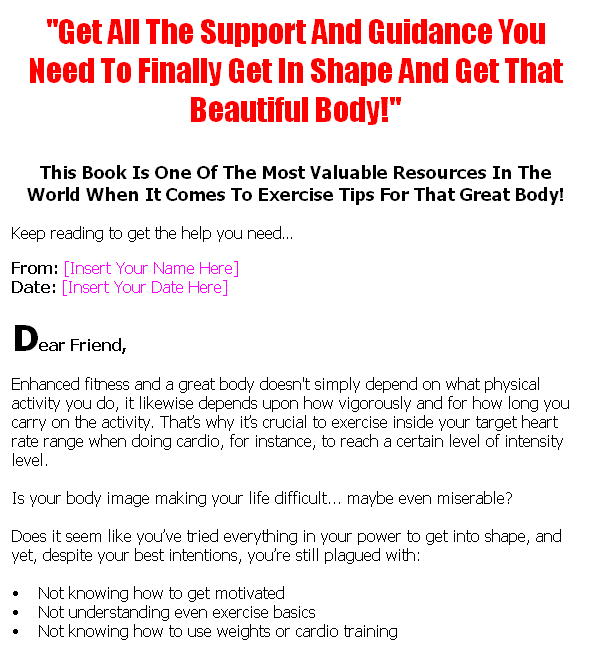Salespage Snapshot:

Table of Contents
Foreword
Chapter 1:
Exercise Basics
Chapter 2:
Set Your Goal And Stick To It
Chapter 3:
Get Your Exercise Plan Together
Chapter 4:
Make Sure To Warm Up
Chapter 5:
Incorporate Cardio Training
Chapter 6:
Use Weights
Chapter 7:
Eat Healthy
Chapter8:
The Benefits To A Healthy Lifestyle Other Than Looking Great
Wrapping Up
Sample Content Preview
Chapter 4:
Make Sure To Warm Up
Synopsis
Many athletes perform some sort of regular warm-up and cool off during training and racing. A suitable warm up may step-up the blood flow to the working muscle which results in diminished muscle stiffness, less risk of trauma and bettered performance. Additional advantages of warming up include physiologic and psychological preparation.
Warm Up
Advantages of a Suitable Warm Up:
Modified Muscle Temperature – The temperature step-ups inside muscles that are utilized during a warm-up routine. A warmed up muscle both contracts more forcefully and loosens up more promptly. In that way both speed and strength may be heightened. Likewise, the chance of pulling a muscle and causing trauma is far less.
Modified Body Temperature – This betters muscle elasticity, likewise cutting back the risk of strains and pulls.
Blood Vessels Enlarge – This brings down the resistance to blood flow and lower strain on the heart.
Better Efficient Cooling – By triggering the heat-dissipation mechanisms in the body (effective sweating) an athlete may cool expeditiously and help preclude overheating early in the event or race.
Modified Blood Temperature – The temperature of blood increases as it goes through the muscles. As blood temperature climbs, the binding of oxygen to hemoglobin de-escalates so oxygen is more readily useable for working muscles, which might better endurance.
Bettered Range of Motion – The range of motion around a joint is modified.
Hormonal Shifts – Your body step-ups its production of assorted hormones responsible for regulating energy production. During warm-up this equilibrium of hormones makes more carbs and fatty acids available for energy manufacturing.
Mental Prep – The warm-up is likewise a great time to mentally prepare for an event by clearing the mind, increasing centering, critiquing skills and technique. Favorable imagery may likewise relax the athlete and establish concentration.
Typical Warm up exercises include:
Bit by bit increasing the intensity of your particular sport. This utilizes the particular skills of a sport and is occasionally called a related warm-up. For runners, the idea is to jog for a while and add a few sprints into the routine to engage all the muscle fibers.
Adding motions not related to your sport in a slow steadfast fashion: calisthenics or flexibility exercises for instance. Ball players frequently utilize unrelated workout for their warm up.
Which to pick? The best time to stretch a muscle is after it has a modified blood flow and has modified temperature to prevent trauma. Stretching out a cold muscle may increase the risk of trauma from pulls and tears.
So you’re better off doing gradual aerobic workout prior to stretching. Bear in mind that the best time to stretch is after your workout as your muscles are warm and pliable with the increase of blood in
them. Make certain your warm up starts out gradually, and utilizes the muscles that will be strained during workout.
Keep in mind that the perfect warm up is a very individual process that may only come with practice, experimentation and experience. Try warming up in various ways, at various intensities until you find what works best for you.
Chapter 5:
Incorporate Cardio Training
Synopsis
With a big share of Americans overweight, it’s clear that a lot of us are not abiding by the most recent exercise guidelines dictating up to an hour of exercise every day. In fact, there is no doubt a collective groan when individuals recognized they’d now have to find an hour every day to accomplish something they can’t seem to find five minutes for. How crucial are these guidelines and what may you do to make them fit into your life?
Cardio Basics
Before we get started, you ought to at least know why it’s so crucial. Cardiovascular exercise merely means that you’re involved in an activity that elevates your heart rate to a level where you’re working, but may still talk (also known as, in your Target Heart Rate). Here’s why cardio is so crucial:
It’s one way to burn off calories and help you slim down
It makes your heart strong so that it doesn’t have to work as grueling to pump blood
It step-ups your lung capacity
It helps bring down risk of heart attack, elevated cholesterol, hypertension and diabetes
It makes you feel great
It aids you in sleeping better
It helps bring down tension
I could go on all day, however you get the point
Bottom line: you require cardio if you want to get your weight in check and get your tension to a tolerable level.
The opening move is to what kind of activities you’d like to do. The trick is to consider what’s accessible to you, what fits your personality and what you’d feel comfy fitting into your life.
If you like to go outside, running, bicycling, hiking or walking are all great choices. If you love the gym, you’ll have access to stationary bicycles, elliptical trainers, treadmills, row machines, stair masters and more.
For the home exerciser, there are a number of first-class workout videos to try and you don’t require much equipment to get an exceptional home cardio workout.
Bear in mind, you might not know what sort of activity you enjoy yet. That’s all part of the experience, so don’t be frightened to try something and, if it doesn’t work, go on to something else.
Other Details- 1 Article (DOC)
- Ebook (PDF, DOC), 32 Pages
- Salespage (HTML, PSD)
- Squeeze Page (HTML)
- Ecover (PSD, JPG)
- Special Bonus Preview Report (PDF, DOC), 13 Pages
- Promo Emails
- Thank You, Earnings Disclaimer & Privacy Policy Page (HTML)
- File Size: 22,945 KB












